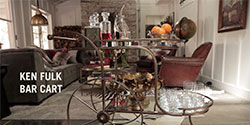How to
Choose the Right
Rug Pad

Rugs add so much comfort and beauty to a home, and they help protect flooring in high-traffic areas. But hiding underneath, there’s something that makes your rug even more useful: rug pads! When you put a pad under a rug, it helps the rug stay put to keep your footing firm. Plus, rug pads can shield your floors over the long-haul from abrasive wear – so they’ll look pristine for years to come. Rug pads also help your rug feel softer under your feet to reduce the stress of standing for long time periods, and they’re perfect for creating a soft spot to lounge on the floor or play with your kids. The really great thing about these pads is that the right one turns any rug into the ideal floor accent for your needs.
A rug pad is a layer of material that rests between the surface of your flooring and under the backing of a throw rug or larger room-sized carpeting. This extra layer helps your rug stay where you put it, which in turn provides added safety and helps prevent tripping or falling on a rug that has shifted. It also adds extra protection for your flooring by cushioning the feet of your furniture. There are three main types of these pads: grip-only, cushioned and grip-plus-cushion. So, how do you choose which one you need?
Grip, Cushion or Both?
Grip-only pads are the thinnest style, and they’re great for outdoor use because they don’t soak up moisture. They’re also ideal for high-traffic areas of your home and for use in areas where you want your rug to have a lower profile, like under the area where a door swings open. Cushioned pads are ideal for indoor use in living rooms and bedrooms where children play, and it’s also great at muting sound. Grip-plus-cushion pads are just right anywhere you want to incorporate a plush layer and add non-skid protection. You can find these types in a wide variety of sizes to suit your indoor and outdoor rugs, and you can also trim some of them to fit.
Do I Need a Rug Pad?
If you have area rugs in your home, it’s beneficial to put a pad under each of them for several important reasons. In addition to increasing your safety and comfort and protecting your flooring, the extra layer of padding makes your rug last longer and hold its shape better. A pad also keeps your rug from shifting when you vacuum. When the pad grips the back of your rug, its slightly sticky texture holds the fibers on the back of the carpet section in place, reducing friction. By stopping the friction that happens when the rug moves against the flooring, it helps to keep the back of your rug from showing signs of wear. A rug pad also protects your flooring from premature scuffs and wear as well because the rug won’t slide back and forth as you walk across it.
How to Choose Rug Pads
The main things to consider when you’re choosing this type of padding are the dimensions, the thickness and the type of flooring in your home. The padding should extend just slightly into the edge of the area rug on all sides. If you’re unsure about which size to choose, it helps to buy a pad that’s a few inches larger than your rug and then use scissors to trim off any excess pad that sticks out. Do you have a round, oval or abstract-shaped area rug? No problem! Most rug pads are easy to trim to your desired size and shape with regular household scissors.
If your flooring is naturally smooth, like hardwood or linoleum, be sure to choose padding that grips – it’s easy to find pads that have textured rubber backings for extra traction. For rugs crafted from natural fibers like sisal and hand-knotted rugs with great texture, a thick pad is a wise idea to keep the floor underneath from showing signs of wear.
Some other things to consider when you’re choosing a padding layer to put under a rug or doormat include your home’s heat source and a desire to fill your home with environmentally friendly items. Pads made from sustainably-sourced materials are available to complement your eco-friendly lifestyle. If your home has radiant heat, padding created from natural fibers stays durable and maintains its strength when your floor’s heating system is operating.


